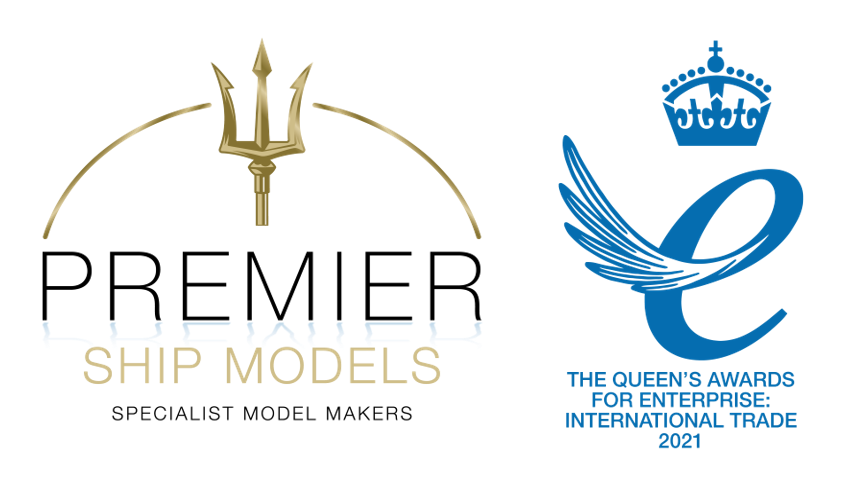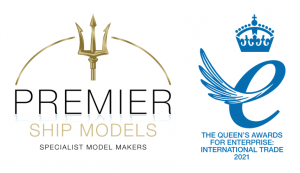In 2023, Premier Ship Models were tasked with constructing a custom Artemis EF-24 catamaran model. It was to measure in at a scale of 1:50, meaning it would be 48 centimetres in length, and it was complete with a striking black and white paint job and stunning exterior detail.
Catamarans are vessels with two parallel hulls of equal size, and the distance between the hulls gifts the boat with extreme resistance to rolling and capsizing. They typically have a much smaller displacement and shallower draft compared to normal boats, as well as significantly less hull volume.
They vary in size from small sailing and rowing ships to large naval boats and even roll-on/roll-off car ferries.
They’re able to travel at such high speeds thanks to their two combined hulls, which have a smaller hydrodynamic resistance when compared to a monohull. This means the ship as a whole needs less propulsive power when contrasted against sails and motors. Furthermore, the catamaran’s wider stance on the surface reduces both heeling and motion caused solely by the waves, meaning the boat produces a smaller wake.
This particular vessel is a passenger ferry and is 100% electric thanks to hydrofoil technology, meaning its impact on the environment is as minimal as possible!
This project was completed for a private client, which is why we cannot share specific details. The client was highly impressed with the clear communication and efficient handling of the project, and they were delighted with the finished product!
It was a pleasure to assist in bringing their vision to fruition, resulting in a meaningful gift for someone special!
This Artemis EF-24 catamaran model was to be 3D printed, and, as mentioned in the overview, it measured 48 centimetres in length (excluding the base).
In terms of materials used, the model was solely constructed from ABS resin, with timber for the base and a brass plaque.
3D-printing is an incredibly complex profession. It requires you to understand three main things:
- The material
- The printer
- The methodology of the piece and your desired end result
The entire process is extremely specialist. Our off-site 3D-printing agent focuses on two skillsets when constructing models: creating the model in a digital manner and readying it for printing, and the separate skillset to take the parts from the printer and get them to a professionally high-standard.
The build-time was set at four weeks, and this criterion was fulfilled without a hitch.
PSM’s custom projects commence with in-depth discussions with the client to ensure complete alignment and bring their vision to life exactly as imagined. We prioritise transparency, providing clients with regular progress updates, and making joint decisions on delivery schedules and payment terms.
Our focus on 3D printing begins with the creation of an initial digital model. We source high-quality materials as outlined in the project brief and use 3D simulation modelling and laser-cutting to ensure precision.
To maintain efficiency, we pause production for client approval of the digital render, allowing for any feedback and subsequent adjustments if necessary. Upon receiving approval, we proceed promptly to save both time and resources.
One intriguing aspect is preparing the actual digital render for 3D printing, which requires specialised software. We break down the render into manageable sections, each part of the model labelled and organised. Advanced software checks the parts for accurate scaling, strength, and waterproofing.
Once the digital render is finalised, we move to laser-cutting and construction. This hands-on phase, known as ‘finishing,’ requires very skilled craftsmanship. We typically divide the hull of a traditional model into three sections, joining them with adhesive and allowing them to dry before adding details. The hull is primed to ensure structural integrity.
Meanwhile, our 3D expert prepares and paints any smaller components individually.
Throughout the process, we keep clients informed with numerous photos and updates. Client satisfaction is our top priority, and we welcome and incorporate feedback to achieve the desired result.
In the case of the Artemis model, we adorned the model with a striking white, black, navy blue and yellow colour scheme, with tinted windows and detailed decals on the sides, as well as metallic support beams for further strength, and an informational plaque in the bottom left corner of the base. The model was also fitted with an acrylic display case for an added layer of protection.
The client was delighted with the finished model and was extremely excited to proudly display it. It was a joy to assist them in crafting a meaningful memento, and working on catamaran models is always enjoyable as they offer ample opportunity for creativity!
We now look forward to our next project with great anticipation and are extremely pleased with the outcome of this one!
Commission your own model
If you would like to have your own bespoke model built, please complete the contact form below.
In 2023, Premier Ship Models were tasked with constructing a custom Artemis EF-24 catamaran model. It was to measure in at a scale of 1:50, meaning it would be 48 centimetres in length, and it was complete with a striking black and white paint job and stunning exterior detail.
Catamarans are vessels with two parallel hulls of equal size, and the distance between the hulls gifts the boat with extreme resistance to rolling and capsizing. They typically have a much smaller displacement and shallower draft compared to normal boats, as well as significantly less hull volume.
They vary in size from small sailing and rowing ships to large naval boats and even roll-on/roll-off car ferries.
They’re able to travel at such high speeds thanks to their two combined hulls, which have a smaller hydrodynamic resistance when compared to a monohull. This means the ship as a whole needs less propulsive power when contrasted against sails and motors. Furthermore, the catamaran’s wider stance on the surface reduces both heeling and motion caused solely by the waves, meaning the boat produces a smaller wake.
This project was completed for a private client, which is why we cannot share specific details. The client was highly impressed with the clear communication and efficient handling of the project, and they were delighted with the finished product!
It was a pleasure to assist in bringing their vision to fruition, resulting in a meaningful gift for someone special!
This Artemis EF-24 catamaran model was to be 3D printed, and, as mentioned in the overview, it measured 48 centimetres in length (excluding the base).
In terms of materials used, the model was solely constructed from ABS resin, with timber for the base and a brass plaque.
3D-printing is an incredibly complex profession. It requires you to understand three main things:
- The material
- The printer
- The methodology of the piece and your desired end result
The entire process is extremely specialist. Our off-site 3D-printing agent focuses on two skillsets when constructing models: creating the model in a digital manner and readying it for printing, and the separate skillset to take the parts from the printer and get them to a professionally high-standard.
The build-time was set at four weeks, and this criterion was fulfilled without a hitch.
PSM’s custom projects commence with in-depth discussions with the client to ensure complete alignment and bring their vision to life exactly as imagined. We prioritise transparency, providing clients with regular progress updates, and making joint decisions on delivery schedules and payment terms.
Our focus on 3D printing begins with the creation of an initial digital model. We source high-quality materials as outlined in the project brief and use 3D simulation modelling and laser-cutting to ensure precision.
To maintain efficiency, we pause production for client approval of the digital render, allowing for any feedback and subsequent adjustments if necessary. Upon receiving approval, we proceed promptly to save both time and resources.
One intriguing aspect is preparing the actual digital render for 3D printing, which requires specialised software. We break down the render into manageable sections, each part of the model labelled and organised. Advanced software checks the parts for accurate scaling, strength, and waterproofing.
Once the digital render is finalised, we move to laser-cutting and construction. This hands-on phase, known as ‘finishing,’ requires very skilled craftsmanship. We typically divide the hull of a traditional model into three sections, joining them with adhesive and allowing them to dry before adding details. The hull is primed to ensure structural integrity.
Meanwhile, our 3D expert prepares and paints any smaller components individually.
Throughout the process, we keep clients informed with numerous photos and updates. Client satisfaction is our top priority, and we welcome and incorporate feedback to achieve the desired result.
In the case of the Artemis model, we adorned the model with a striking white, black, navy blue and yellow colour scheme, with tinted windows and detailed decals on the sides, as well as metallic support beams for further strength, and an informational plaque in the bottom left corner of the base. The model was also fitted with an acrylic display case for an added layer of protection.
The client was delighted with the finished model and was extremely excited to proudly display it. It was a joy to assist them in crafting a meaningful memento, and working on catamaran models is always enjoyable as they offer ample opportunity for creativity!
We now look forward to our next project with great anticipation and are extremely pleased with the outcome of this one!
Commission your own model
If you would like to have your own bespoke model built, please complete the contact form below.


